
Venice is a bunch of small islands that are also densely built up. And there is a special situation with transport. Cars are prohibited, motorcycles are prohibited, bicycles are prohibited. Historically, you can only walk, ride a horse or go boating. There are also problems with the horse in our time - before the bridges were smooth, but today with steps.
As a result, everything that is done in Venice is done from a boat. For example, an ambulance is a speed boat. Does the patient feel bad? We swim along the canal to the place closest to the house and pick it up on a stretcher to the boat.

Historically, aristocrats also did not walk, but moved on richly decorated boats, so the main entrances to the houses always went out onto the canal.
That is, the door of a rich house goes simply to the channel:



Or there is an arch through which you can swim into the courtyard (it is also made of water). By the way, relatively recently, young people at night swam through one such arch into a half-abandoned temple and indulged there in all kinds of indecency.
In neighborhoods poorer, the street simply ends with water:


In general, there is no difficulty to swim straight to the house. That is, if you perceive the channels not as obstacles, but as roads of a special type, you will not be mistaken.
To cross the road there are bridges or boats that will transport you to the other side. Instead of buses - vaporetto river buses.
Another interesting aspect is connected with this “system of roads”. As Venice developed, the islands aligned and merged. Here is Ria Terra, that is, an earthen canal.

They took this canal and made it a pedestrian street. But, on the other hand, the Phoenix Theater had to dig its own separate canal - the aristocracy’s habit of moving everywhere by boat did not allow a wealthy public to arrive by land.

The theater is also magical. Firstly, it was founded as a joint stock company. His only goal was to make money. Secondly, investors were so greedy that they ordered Verviata and Rigoletto from Verdi to have their own cool content. We also ordered from Bellini, after which a cocktail was named. Thirdly, he was called the Phoenix. The theater was fully consistent with its name - it burned twice and was restored both times.
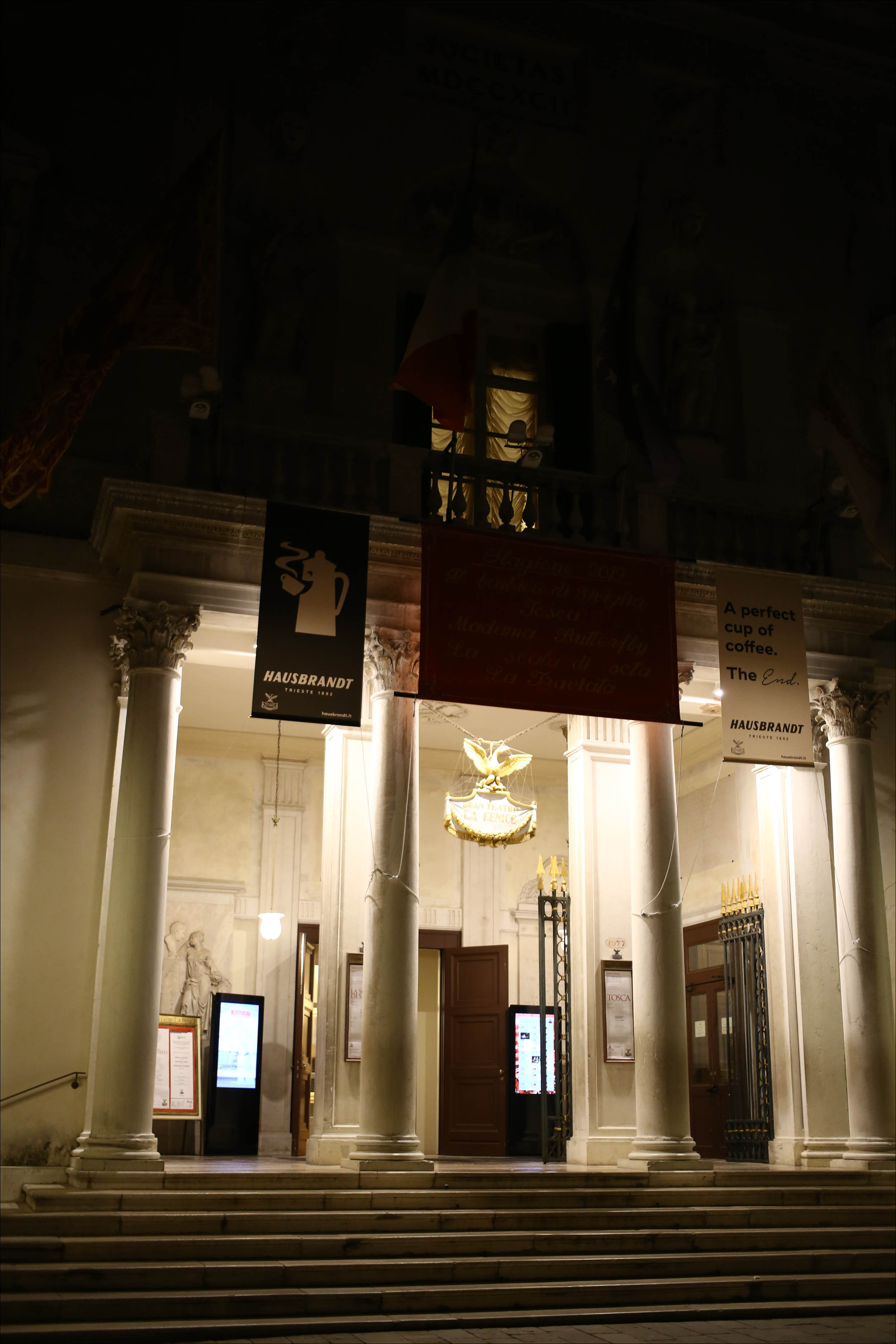
Fire brigade also on boats. Sleeves extend from the fire boat to the house, and there is water in the canal. Nevertheless, when this same “Phoenix” was burning for the second time (it seems that the bike goes that the reconstruction contractor did not have time for the contract and arranged the arson), at the same time almost half of the city burned down. Because at that very moment there was a big shallowing of the canals, and fire boats simply could not get to the theater. They got a helicopter from somewhere, but he was alone, and did not help much.

From this moment on, they decided to create a hydrant system in the city - there was just a new water supply from the mainland, and emergency cranes were made. It sounds strange - they say, why are hydrants in the city on the water, but after the story with the theater it becomes clear what the matter is.

This is not just laundry hanging in the yard, it is actually a photograph of a hydrant in its habitat.
The only traffic light on the channels was made just for firefighters - when something is on, it lights up in red, blocks the Grand Canal, and they rush to the place of ignition.
Similarly, firefighters work as golden collectors. Only firefighters fill something with water, and goldsmiths, on the contrary, pick out waste from houses. Here I must say a few words about the sewer. At first, everything was simply thrown out and poured into the channels. The ebb and flow, the channels are pumped and carry everything into the lagoon from the city. Fish is introduced into the lagoon, for example, near Burano. The city stinked, as almost all medieval cities stole except Prague. In Prague, unlike other cities, it smelled of blood from the pavements in the center. With the advent of ideas about sanitation, septic tanks began to be made with three cameras: for the toilet, for the kitchen and for everything else. On top of the gutter for water from the channels. As a result, purified water comes out, and solid residues are condensed in the septic tank. The first septic tanks were made from what came out - for example, a tree. But it was still better than nothing.
Now, where it is impossible to put a septic tank (it’s too difficult to reconstruct at home), filters are used that need to be changed very often (once a week). If something dirty flows into your canal from your home, today you will be fined.

Taxis are also water - these are about the same boats as ambulances, only for passengers. There used to be a saying that the most arrogant inhabitants of Venice are pigeons and gondoliers. Now the list is supplemented by taxi drivers. A license (according to local ones) costs almost 800 thousand euros, a taxi at golden prices, but in some places irreplaceable. According to the conditions, a taxi driver can put an assistant to replace (something like a master and apprentice system), but is fully responsible for his actions. As a result, again, according to the locals, taxi drivers themselves almost do not work, and their apprentices smack in. Plus, I directly suspect that working with a bunch of cash and not very advanced tax control - and now the license pays off quickly. Well, they have the same closed community, about the same as gondoliers.
Gondoliers
Venice is very difficult to imagine without gondolas. Half an hour costs 70 euros during the day and 100 euros at night (because the wind rises, it’s more difficult to rule). A gondola is an asymmetric bent-tail boat:

He bends so because there is a gondolier with an oar and rowing. It is more convenient to do this when the oar, and not you, is located on the longitudinal axis of the boat. The shape of the boat and its decorations are regulated, for example, this symbolic thing on the bow is almost a flag.

S-bend repeats the shape of the Grand Canal. Six dice symbolize 6 quarters of the city. Arch - the main bridge of Rialto. Stars between the dice - three islands nearby (Murano, Burano, Torcello). The cap is the crown of the doge (it is about this shape). The boats themselves are black and quite the same for a reason - they are echoes of the show-off between the aristocrats, which ended with a normative act regulating that you can’t hang out, all should be about the same, all the boats should be black. Want to stand out - sponsor a church.

The Baroque style was designed like this: a rich facade with slots for statues. Then they tried to sell the facade to one of the rich. If it turned out, the key statue or bust was from the sponsor, and the church was built with chic. Sometimes it didn’t work out - then the facade was simply not done, they built a house like a house. This church was sponsored by the admiral, here is his large statue. Today, cultural monuments are also not made with municipal money - they are looking for a sponsor. For example, an incredibly healthy Visa banner hangs on the main square, like, save the city, pay with our cards - and it will hang until everything is repaired there.
Since the channels are small, there is no keel, and the draft is only about 20 centimeters. Therefore, gondoliers do not like taxi drivers - they drive motor boats and raise a wave. About three gondolas flip over a year, which means a huge scandal with tourists inside.

By the way, quite normal rules of channel movement apply in channels. Instead of blinkers - shouting "I'm going to the left", "I'm going to the right" as a defense against collisions. The speed limit is 10 kilometers per hour in the city, 20 kilometers per hour in the lagoon. Engines for 9.9 horsepower are common, this is like our scooters - there is no VIN on the engine, so there is no one to send a penalty for exceeding.

Boats must be equipped with marker lights.
Such a restriction in the city because the Venetians are doing their best to reduce the waves, as they destroy the embankments of the canals.
By the way, embankments of canals. They are slightly elevated above the water level, because there is the sea, and there are ebbs and flows. Even when the wind blows in one direction, there can be shallowing, in the other direction - a flood.

Visible rise

Here you can see the old embankment and the new one, and there are water level marks
Here, look, the dams on the houses:


And here the emergency sidewalks are already laid in anticipation of flooding (almost every fall):
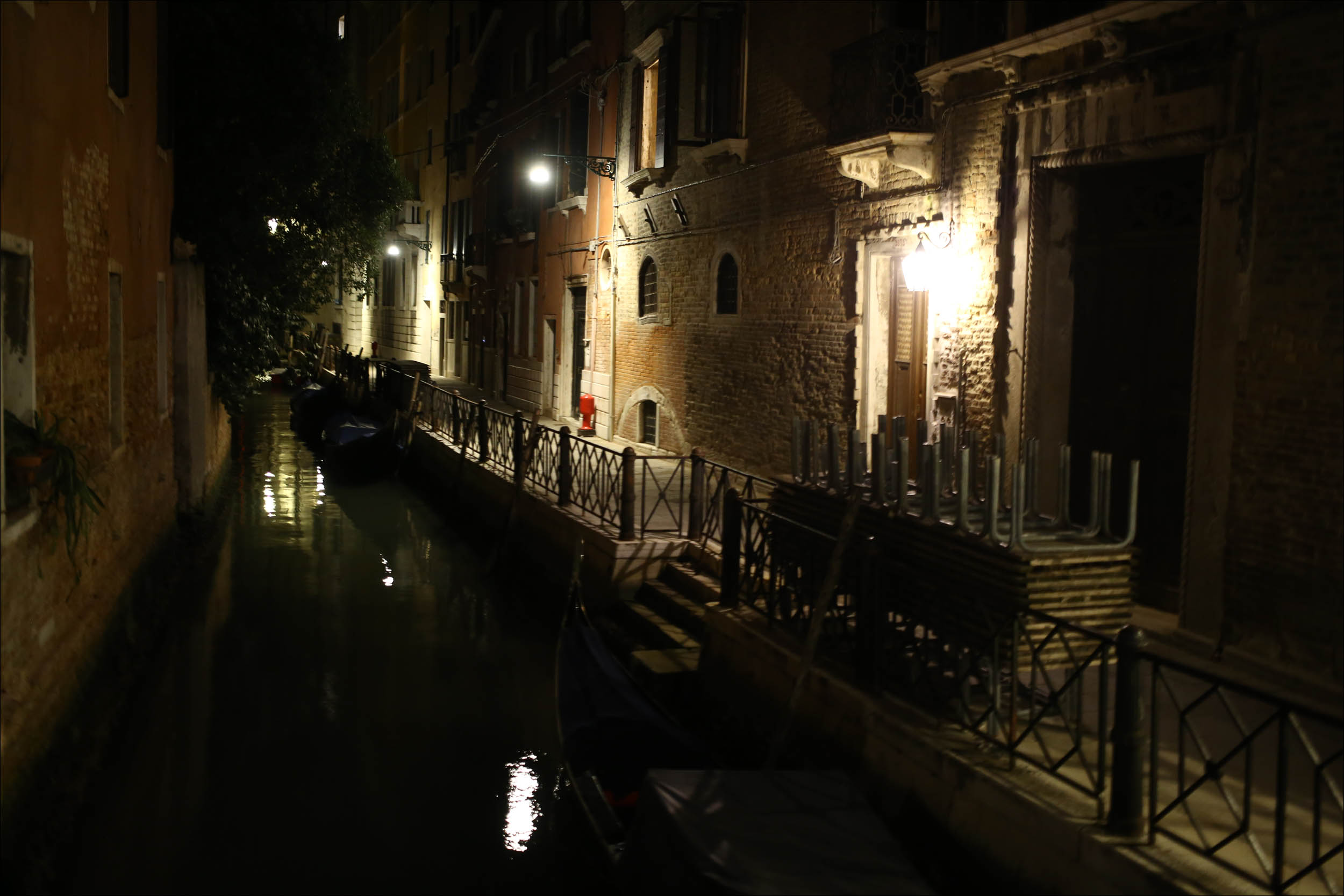
During a flood, a siren starts. One sound is 1.1 meters above sea level, just close the mini-dams and sleep peacefully while the water is knocking at your house. Two beeps - 1.2 meters, the same thing, but you can expect a surprise. Three beeps - water will go to the houses through the floor tiles. At this point, the owners of warehouses and stores begin to feverishly rescue the goods. The first floors of the houses are almost uninhabited due to humidity (well, they either surrender to tourists, and tourists leave by the flood season), so everything will be fine at home. But not in the store. 1.4 meters - you have a khan, a large-scale reconstruction awaits the city. Last year, in October there were 1.6 - people walked around the streets with shoe covers and wallets in their hands, children caught fish with their hands, at night jellyfish swam along the bridge.
But back to the gondoliers. Then again from the words of local people (prices are checked by three different people, but may differ from the real ones). So, to make money cool on tourists, you need a boat. It costs a total of about 35 thousand euros. Moreover, the same oarlock for a single oar is usually made in the form of a figure, and this composition costs a piece of the euro, too. Therefore, gondoliers often take her home in the evening, so that cunning tourists do not twist a souvenir. But the boat is only half the battle. Still need a license. The license is obtained almost like a taxi, through a difficult exam and a lot of money (about 150 to 500 thousand euros, according to my information, depending on the route). Gondoliers are actually united in a closed dynastic community - like undertakers in Russia. Therefore, getting into this market is very difficult: the exam is taken or not accepted by people from within the community. Without a license, you can ride a gondola only for private purposes (to be something like a personal driver). In total, Venice has around 450 gondolas with licenses.

Representative of this glorious profession. In general, taking into account EU legislation regarding biometric data, it is surprising that he gave permission to shoot.
Gondolas run in circular routes and have a clear starting point. That is, along with obtaining a license, you get a point in the city at the striped pillar. Such striped pillars cannot park ordinary boats.
In winter, gondoliers dress up in Santa Claus and sail to the parade in the Grand Canal. Last year, our compatriot in a snowball costume was spotted there, but she does not have a license for public transportation (as far as I know).
And canals freeze in winter?
Very rarely, every 10-20 years for a couple of days. And more often chalk, but also not for long. The water in the canals is sea, that is, salty, and really low temperatures are needed for freezing, which are difficult to obtain in this climate. But with abnormal cooling, this happens:
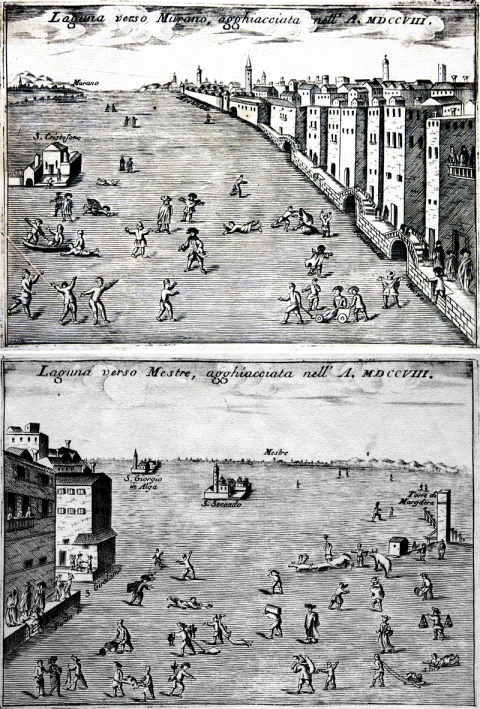
Here is a very detailed publication in English about all freezing, the picture from there
Snow in Venice can be caught, but it usually does not reach the ground and melts. For a year, one or two times you can see the white pavements.
And what, each resident has his own boat?
Yes and no. The problem with parking spaces, boats are sold only with them. Finding a parking is more difficult than buying a boat - the regulation goes exactly to the storage places. Now the mayor promises new parking spaces to everyone, but it seems to be somewhere on the outskirts.

As a result, many indigenous people have boats, and for the rest, they have vaporetto and tragetto.
Tragetto is a boat through the canal, a short route from the pier to the pier, replacing the bridge. Vaporetto is a water bus. A network of river buses covers the city. Day and evening (at the end of the performances), these little boats are clogged like our subway cars at rush hour in Moscow, that is, there really can not be pushed. And mostly these are tourists. Therefore, priority passes have been made for local people at the marinas - you can attach a red pass and go to the main crowd to land. At the same time, there are no seats in the waiting rooms for priority landing, but in ordinary ones there are. This is because tourists wait 5-10 minutes, and locals come directly to the tram - they go very accurately.

Many houses are designed specifically to be watched from the water. The main facades are turned onto the canal.
Vaporetto walks along the lagoon, in particular, to the islands of Murano, Burano, Torcello and the cemetery island. The fairway is marked with milestones.
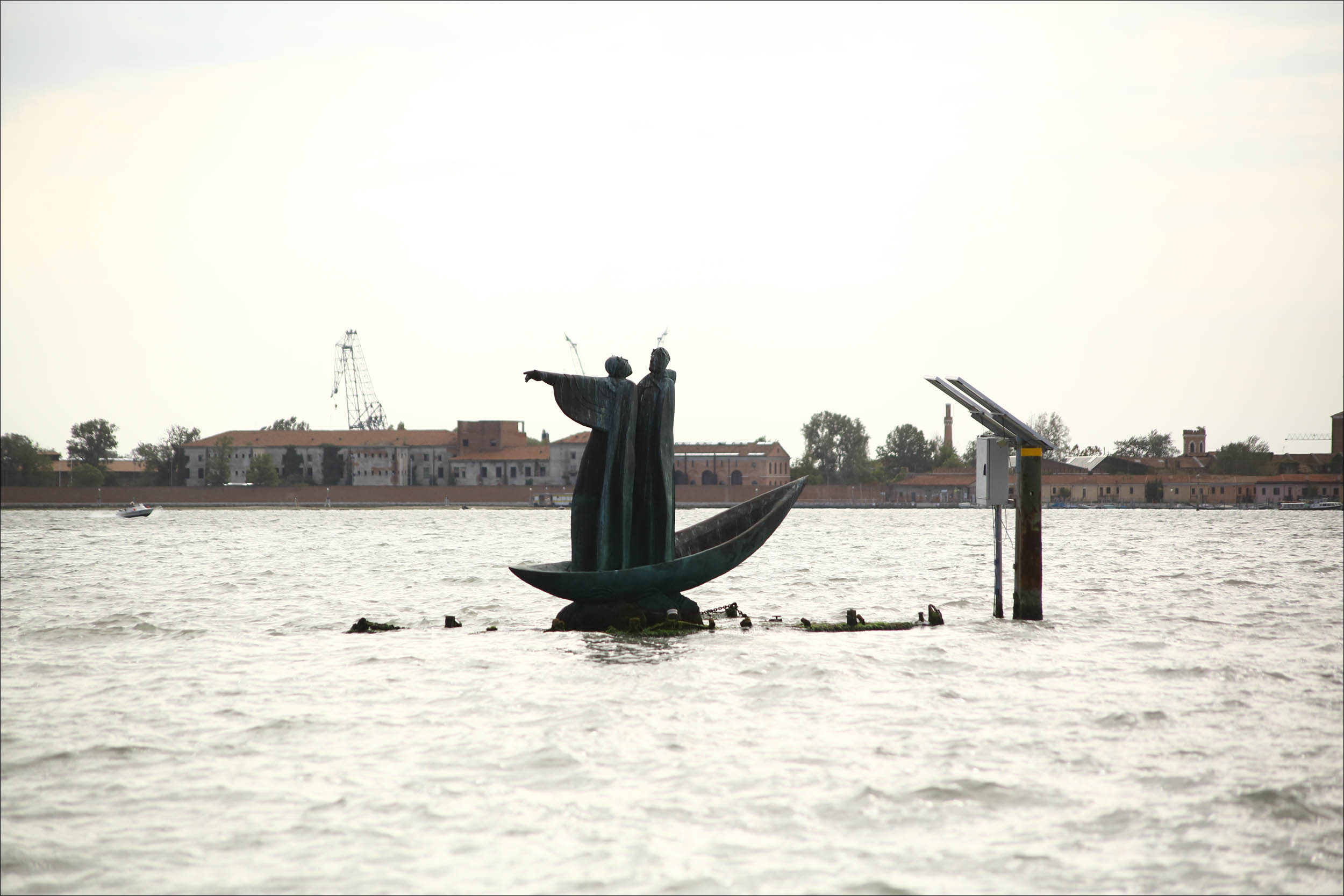
Rook Dante, sailing to hell (on a local island with a cemetery), details are here in this LJ. They usually remove a monument without solar panels, but they are needed for lighting at night.

Real professionals do not use fenders, so sticks can be chipped like this. And so they are not made of concrete or steel, by the way.

More transport
The entrance terminal is made for the People Mover light metro, which runs through a small strait from the island with lots of parking lots. An electric train comes to the same entrance area, and buses nest there. From the airport you can come both to the parking island and directly to this square. At this point, the usual transport ends. Next up is the vaporetto system. A ticket costs 7.5 euros, a ticket for 24 hours - 20 euros (applies to buses and other in the mainland). Travel tickets are sold at tobacco kiosks. There, by the way, there are awesome GPS mailboxes.
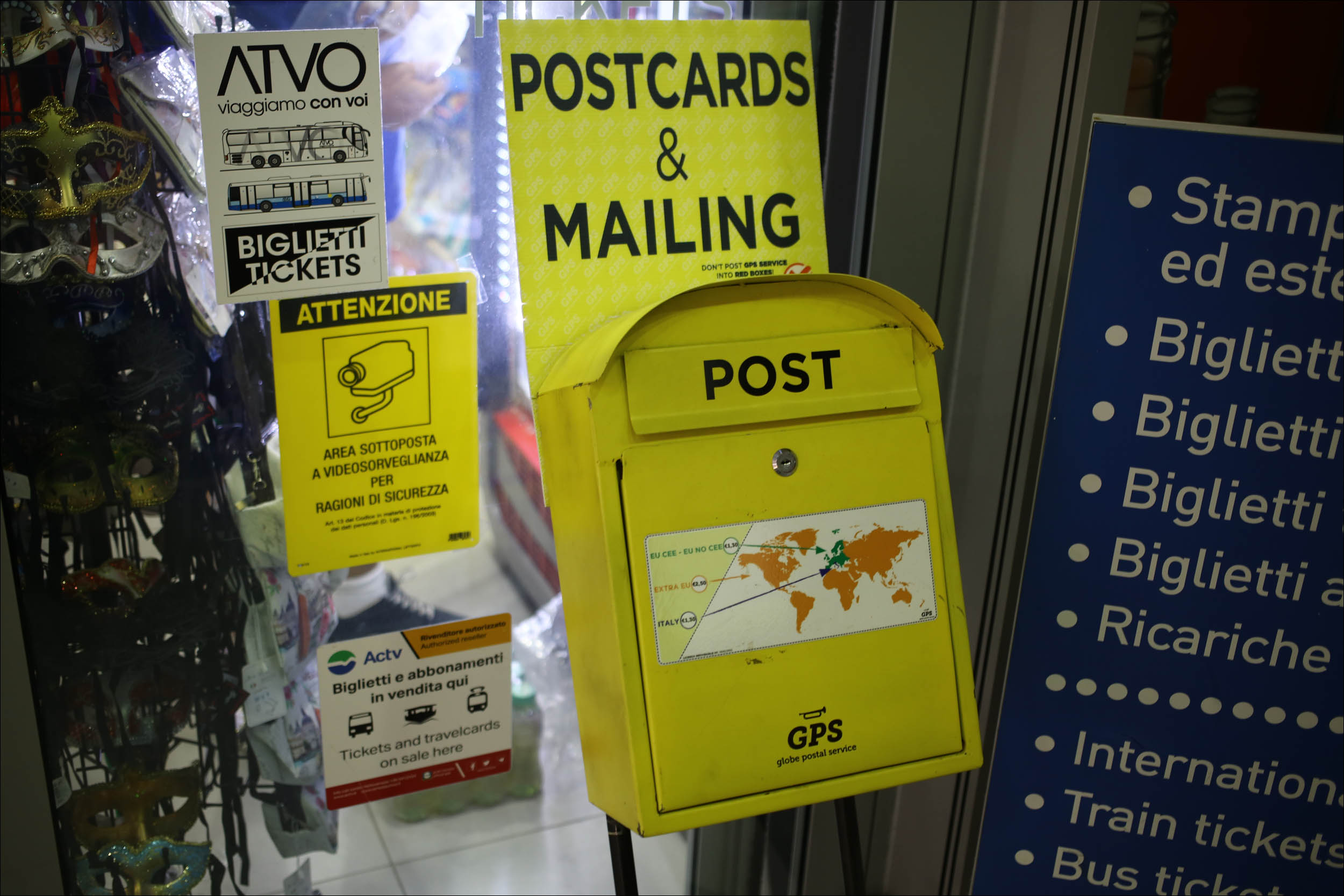
This post is a separate cool invention: yellow boxes are in almost all tobacco and souvenir boxes, and you can buy stamps with a QR code. Further on this brand is tracking (received in the terminal, given from the terminal, the recipient scanned the code), and you can directly attach a video to the card, then the recipient can watch it from the phone. Much more convenient than classic mail, but also more expensive.
This is what the people remover looks like:

Rails are divided at stations, tree-houses. More precisely, at the central station, because there are only three of them, and two of them are final.
Service boats
Since canals are roads, there are many service boats on them. Delivery of goods to stores, transportation of furniture - all by boat.

Morning unloading seems like for coop

SCS will not build itself
These manipulator cranes are a very common occurrence on a boat, an almost standard set of equipment:

But the builders work:

And here the most interesting thing happens - the parking pole is updated: it is driven into the bottom of the channel with a special thing:

The canals are also serviced: they gradually overgrow with sludge, sand is washed in from the mainland, and so on - they need to be deepened about once every 30-40 years.
That's it, the boat-town is arranged from the transport side. Yes, I remember about Ruskeala, but about Venice I still need to tell an enchanting story about how they generally managed to build a rich marine empire and at the same time their little Arzamas-16 of the Middle Ages in this empty and unfriendly place. Well, in our hub Tutu.ru there is a lot about other types of transport.